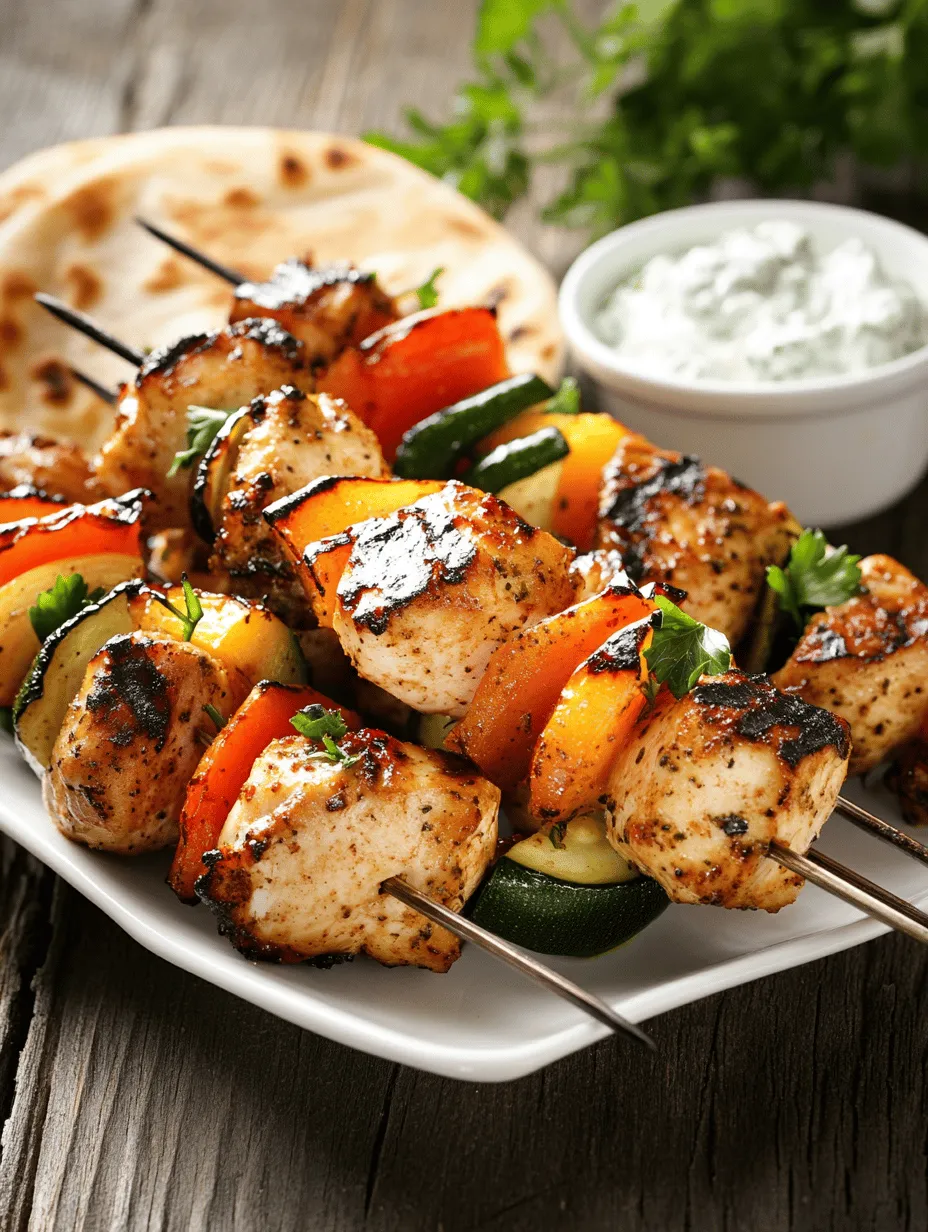Introduction
In the world of culinary delights, few dishes can rival the vibrant and aromatic appeal of grilled chicken kabobs, especially when inspired by Middle Eastern flavors. These delectable skewers, bursting with spices and grilled to perfection, offer a taste of rich cultural heritage and culinary tradition. The art of creating succulent grilled chicken kabobs is not just about cooking; it’s about infusing flavors, textures, and colors into a single dish that can bring people together.
This article delves into the intricacies of preparing grilled chicken kabobs, highlighting essential ingredients, marination techniques, and grilling methods that bring this dish to life. With a perfect blend of spices and fresh vegetables, these kabobs are not merely a meal but a celebration of culture and taste. Whether you’re planning a backyard barbecue or a cozy family dinner, this recipe will guide you through every step, ensuring that your kabobs are as delightful as they are flavorful.
Understanding the Ingredients
The foundation of any great dish lies in its ingredients. When it comes to grilled chicken kabobs, selecting high-quality, fresh ingredients is paramount for achieving that authentic taste. Each component plays a critical role in the overall flavor profile, and understanding them will enhance your cooking experience.
Boneless, Skinless Chicken Thighs
Choosing the right cut of chicken is crucial for the success of your kabobs. While chicken breasts are a popular option, boneless, skinless chicken thighs are the preferred choice for many chefs and home cooks alike. Here’s why:
1. Flavor: Chicken thighs are known for their richer flavor compared to breasts. They contain more fat, which contributes to a juicier and more flavorful end product.
2. Moisture Retention: Thighs are less likely to dry out during the grilling process, making them ideal for kabobs. The additional fat helps to keep the meat tender and succulent, ensuring that each bite is bursting with flavor.
3. Versatility: Thighs absorb marinades exceptionally well, allowing them to soak up the aromatic spices and create a harmonious blend of flavors.
By opting for chicken thighs, you elevate the overall taste of your kabobs, resulting in a dish that is both mouthwatering and satisfying.
Olive Oil and Lemon Juice
The next key elements in our kabob recipe are olive oil and lemon juice, both of which play significant roles in the marination process:
1. Olive Oil: This healthy fat enhances the moisture content of the chicken, preventing it from drying out during grilling. Additionally, olive oil acts as a carrier for the spices, helping to evenly distribute their flavors throughout the meat.
2. Lemon Juice: The acidity of lemon juice is essential for tenderizing the chicken. It breaks down the protein fibers, resulting in a more tender texture. Moreover, the bright, zesty flavor of lemon juice complements the spices beautifully, adding a refreshing note to the overall dish.
Together, olive oil and lemon juice create a luscious marinade that enhances both flavor and texture, setting the stage for delicious kabobs.
Aromatic Spices: Garlic, Cumin, Coriander, Smoked Paprika, Turmeric, Cinnamon
The heart of Middle Eastern cuisine lies in its array of spices, and our grilled chicken kabob recipe is no exception. The following spices not only contribute to the flavor but also boast numerous health benefits:
1. Garlic: Known for its distinct flavor and aroma, garlic also offers antibacterial properties and supports immune health. It adds depth to the marinade and enhances the overall taste.
2. Cumin: This warm spice is a staple in Middle Eastern cooking, known for its earthy, nutty flavor. Cumin aids digestion and is rich in antioxidants, making it a great addition to our kabobs.
3. Coriander: With its citrusy flavor, coriander complements the other spices beautifully. It is also packed with vitamins and minerals, enhancing the nutritional value of the dish.
4. Smoked Paprika: This spice adds a subtle smokiness and vibrant color to the kabobs. Smoked paprika is rich in antioxidants and can help reduce inflammation.
5. Turmeric: Known for its bright yellow color and health benefits, turmeric is a powerful anti-inflammatory agent. Its warm, slightly bitter flavor adds complexity to the marinade.
6. Cinnamon: A surprising addition to savory dishes, cinnamon lends a warm sweetness that balances the spices. It also has antibacterial properties and is known to stabilize blood sugar levels.
Together, these aromatic spices create a robust flavor profile that truly embodies the essence of Middle Eastern cuisine.
Fresh Vegetables: Onion, Bell Pepper, Zucchini
No kabob is complete without the addition of fresh vegetables, which not only add color and visual appeal but also contribute to the overall flavor and texture of the dish. In our grilled chicken kabobs, we recommend using:
1. Onion: Onions caramelize beautifully when grilled, adding a sweet and savory element to the kabobs. They also provide a satisfying crunch that contrasts with the tender chicken.
2. Bell Pepper: Colorful bell peppers are a great choice for kabobs, adding both sweetness and a pop of color. They are rich in vitamins A and C, making them a nutritious option.
3. Zucchini: Zucchini adds a mild flavor and a slight crunch to the kabobs. This vegetable cooks quickly and retains its moisture, complementing the juicy chicken perfectly.
By incorporating these fresh vegetables, your kabobs will not only be visually appealing but also packed with essential nutrients, making for a well-rounded meal.
Garnishes and Accompaniments: Parsley, Pita Bread, Tzatziki Sauce
To truly elevate your grilled chicken kabobs, consider adding garnishes and traditional accompaniments that complement the dish:
1. Parsley: Fresh parsley adds a burst of color and a hint of freshness to your kabobs. It can be chopped and sprinkled on top before serving, enhancing both presentation and flavor.
2. Pita Bread: Soft, warm pita bread is perfect for serving alongside kabobs. It can be used to wrap the meat and vegetables, creating a delicious handheld meal that is both satisfying and easy to eat.
3. Tzatziki Sauce: This creamy, tangy yogurt-based sauce is a classic accompaniment to grilled dishes. Made with cucumbers, garlic, and herbs, tzatziki adds a refreshing contrast to the rich flavors of the kabobs.
These garnishes and sides not only enhance the dining experience but also provide a glimpse into the traditional ways Middle Eastern dishes are enjoyed.
Marinating the Chicken
The marination process is crucial for infusing flavors into the chicken, ensuring that every bite is brimming with the aromatic spices and zest of the marinade. This section breaks down the steps for creating the perfect marinade.
Creating the Marinade
To create a luscious marinade for your grilled chicken kabobs, follow these simple steps:
1. Combine Ingredients: In a mixing bowl, combine olive oil, lemon juice, minced garlic, and all the aromatic spices: cumin, coriander, smoked paprika, turmeric, and cinnamon. Whisk the mixture until it is well blended.
2. Add Chicken: Place the boneless, skinless chicken thighs in a large resealable plastic bag or a shallow dish. Pour the marinade over the chicken, ensuring that each piece is well-coated.
3. Seal and Refrigerate: If using a plastic bag, seal it tightly, removing as much air as possible. If using a dish, cover it with plastic wrap. Refrigerate for at least 1 hour, but preferably for 4 to 6 hours, allowing the flavors to meld and penetrate the meat.
Importance of Marination Time
Understanding the science behind marination is essential for achieving optimal flavor and tenderness in your chicken kabobs. Here’s why marination time matters:
– Flavor Absorption: The longer the chicken marinates, the more flavor it absorbs. The acidic components (like lemon juice) help to break down the proteins in the meat, allowing the spices to penetrate deeply.
– Tenderness: As the chicken sits in the marinade, the acidic ingredients work to tenderize the meat, resulting in a juicy and succulent kabob. Marinating for longer periods (up to 24 hours) can yield even more tender results.
– Convenience: Marinating allows for meal prep ahead of time. You can easily prepare the chicken the night before and have it ready to grill when you need it, making your cooking experience more seamless.
Tips for Optimal Marinade Absorption
To ensure that your chicken absorbs the maximum amount of flavor from the marinade, consider these insider tips:
1. Score the Chicken: Lightly scoring the surface of the chicken thighs with a sharp knife can help the marinade penetrate more effectively. This creates small channels in the meat for the flavors to seep in.
2. Use a Vacuum Sealer: If you have one, using a vacuum sealer can enhance the marination process by removing air and ensuring the marinade fully envelops the chicken.
3. Massage the Marinade: After adding the marinade to the chicken, massage it gently to ensure even coverage. This also helps to break down the meat fibers, aiding in tenderness.
By following these tips, you’ll maximize the flavor infusion, resulting in kabobs that are truly unforgettable.
Preparing the Skewers
Preparation is key to achieving the perfect kabob. This section details how to prepare the skewers and arrange the ingredients for grilling.
Choosing the Right Skewers
When it comes to skewering your chicken and vegetables, selecting the right type of skewers is essential for both ease of use and the final presentation. Here’s a breakdown of the options available:
1. Metal Skewers: Reusable metal skewers are an excellent choice for grilling. They conduct heat well, ensuring that the food cooks evenly. Additionally, they do not require soaking (unlike wooden skewers) and are easy to clean after use.
2. Wooden Skewers: If you prefer a more traditional approach, wooden skewers are a viable option. However, you must soak them in water for at least 30 minutes prior to grilling to prevent them from burning. Wooden skewers are also lightweight and easy to handle.
3. Flat Skewers: Flat skewers are designed to prevent food from spinning during grilling, making it easier to turn your kabobs without losing any ingredients. They are available in both metal and wooden options.
Choose the type of skewer that best fits your grilling method and preferences, ensuring a hassle-free cooking experience.
With the right ingredients, marination techniques, and preparation methods, you’re well on your way to mastering the art of grilling chicken kabobs in the Middle Eastern style. As we continue this culinary journey, we’ll explore the grilling process, tips for achieving perfect kabobs, and serving suggestions that will make your dish a standout at any gathering. Stay tuned for the next part of this delicious recipe adventure!

Wooden versus Metal Skewers
When it comes to choosing skewers for your grilled chicken kabobs, you’ll encounter two main types: wooden and metal. Each has its benefits and drawbacks that can affect your grilling experience.
Wooden Skewers: These are typically less expensive and can be found in most grocery stores. However, one of the major issues with wooden skewers is their tendency to burn if not properly prepared. To prevent this, soak wooden skewers in water for at least 30 minutes before threading on your ingredients. This soaking process hydrates the wood, allowing it to withstand higher temperatures without igniting. Additionally, soaking can help to keep the kabobs moist since the water will steam during cooking, adding an extra layer of flavor.
Metal Skewers: On the other hand, metal skewers are durable, reusable, and eliminate the risk of burning. They conduct heat better than wood, which can lead to more evenly cooked kabobs. However, they can sometimes be more challenging to handle, as they become extremely hot during grilling. A good compromise is to choose flat metal skewers, which are less likely to spin when you try to turn them, ensuring even cooking for all ingredients.
Assembling the Kabobs
Assembling your chicken kabobs is an enjoyable and creative process. Start by preparing your marinade and letting the chicken soak in it for the recommended time. Once ready, gather your skewers and follow these steps for an even distribution of chicken and vegetables:
1. Prepare Ingredients: Cut your chicken and vegetables into uniform pieces. This ensures they cook evenly. Aim for about 1 to 1.5-inch cubes for the chicken and similar sizes for the vegetables.
2. Thread the Skewers: Begin by threading a piece of chicken onto the skewer, followed by a piece of bell pepper, onion, and zucchini. Alternate the ingredients to create a visually appealing kabob. Keep the pieces close together but not too tightly packed; this allows for even cooking and proper air circulation.
3. Repeat the Process: Continue threading until the skewer is filled, leaving a little space at both ends for easier handling. Repeat this process for the remaining skewers, ensuring that each kabob has a balanced mix of chicken and vegetables.
Grilling Techniques
Grilling chicken kabobs requires precision and attention to detail. Here are essential techniques to ensure perfectly grilled kabobs.
Preheating the Grill
Preheating your grill is crucial for achieving those beautiful char marks and ensuring your kabobs cook evenly. Aim to preheat your grill to medium-high heat, around 375-400°F (190-200°C). This temperature will create a nice sear on the chicken while keeping the inside juicy and tender.
Cooking Time and Techniques
The cooking time for chicken kabobs typically ranges from 10 to 15 minutes, depending on the thickness of the chicken pieces and the heat of the grill. Here are some tips to monitor cooking time and achieve even grilling:
– Turn Regularly: Rotate the kabobs every few minutes to ensure all sides cook evenly. This technique prevents burning and helps achieve that coveted grill mark.
– Watch for Color Changes: Keep an eye on the color of the chicken. It should go from pink to a beautiful golden brown. Vegetables may also soften and become slightly charred, which enhances their flavor.
Checking for Doneness
To ensure that your chicken kabobs are safe to eat, it’s essential to check for doneness. Use a meat thermometer to measure the internal temperature of the chicken pieces. The USDA recommends that chicken reaches a safe internal temperature of 165°F (75°C). Insert the thermometer into the thickest part of the chicken to get an accurate reading. Once you’ve reached the correct temperature, remove the kabobs from the grill and let them rest for a few minutes before serving.
Serving Suggestions
Presentation and serving play a significant role in the overall dining experience. Here are some ideas for serving your grilled chicken kabobs attractively:
Plating the Kabobs
To create an appealing presentation, serve the kabobs directly on a platter or individual plates. You can enhance visual appeal by garnishing with fresh herbs like parsley or cilantro. A sprinkle of sumac or a drizzle of olive oil can also add an extra touch of flavor and color.
Pairing with Pita Bread and Tzatziki Sauce
Traditional accompaniments for chicken kabobs include warm pita bread and tzatziki sauce. The soft, pillowy pita is perfect for wrapping around the kabobs or scooping up any leftover sauce. Tzatziki, a refreshing yogurt-based sauce with cucumber, garlic, and dill, adds a cool contrast to the savory flavors of the kabobs. You can easily make tzatziki at home by combining Greek yogurt, grated cucumber, minced garlic, lemon juice, olive oil, and seasoning to taste.
Creating a Complete Meal
To create a balanced meal, consider serving your grilled chicken kabobs alongside Mediterranean-style side dishes. A classic tabbouleh salad made with parsley, tomatoes, mint, and bulgur wheat pairs beautifully with the kabobs. You could also serve a simple Greek salad with cucumbers, tomatoes, red onions, olives, and feta cheese drizzled with olive oil and lemon juice. For a heartier option, serve a side of couscous or rice pilaf, which will complement the flavors of the kabobs and provide a wholesome base for your meal.
Cultural Significance and Variations
Grilled chicken kabobs embody the rich culinary heritage of Middle Eastern cuisine. These skewers are not just a meal; they represent shared traditions, family gatherings, and festivals.
Traditional Middle Eastern Kabobs
Kabobs come in various forms across different Middle Eastern countries, each with unique ingredients and preparation methods. For example, in Iran, you might find kebab koobideh, which is made with ground meat and spices, grilled on flat skewers. In Turkey, şiş kebabı features marinated chunks of meat threaded with tomatoes and peppers. Each region has its own twist, showcasing the local flavors and culinary techniques.
Contemporary Twists on Kabobs
In modern culinary practices, kabobs have seen various adaptations to cater to diverse dietary preferences. For those who prefer vegetarian options, consider replacing chicken with marinated tofu or a selection of hearty vegetables like eggplant, mushrooms, and bell peppers. Gluten-free variations can replace traditional marinades containing soy sauce with gluten-free alternatives or simply rely on herbs and spices for flavor. There are endless possibilities to explore, allowing everyone to enjoy the delightful experience of grilled kabobs.
Conclusion
Grilled chicken kabobs are a culinary delight that encapsulates the essence of Middle Eastern cuisine, offering a harmonious blend of spices, textures, and aromas. With the right ingredients, grilling techniques, and presentation, you can create a dish that not only satisfies hunger but also brings people together. By following this comprehensive guide, home cooks can embark on their culinary journey, mastering the art of kabob-making and enjoying the rich flavors that make every meal an occasion worth celebrating. Whether preparing for a family gathering or a casual weeknight dinner, grilled chicken kabobs promise to deliver a taste of tradition and warmth, inviting everyone to the table.


